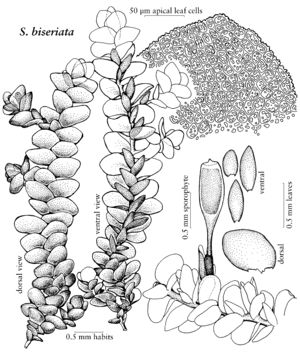familyErpodiaceae
genusSolmsiella
Show Lower Taxa
Solmsiella
Bot. Centralbl. 19: 149. 1884 ,.
Etymology: For H. M. C. L. F. zu Solms-Laubach, 1842–1915, German botanist
| Taxon | Illustrator ⠉ | |
|---|---|---|
 | Solmsiella biseriata | Patricia M. Eckel |
Plants dull, light to yellow-green, becoming brownish with age. Leaves ± complanate both dry or wet, arranged in 4 rows, dimorphic, dorsal leaves larger, ± asymmetric, ventral leaves smaller, ± symmetric; laminal cells pluripapillose. Perichaetial leaves slightly enlarged, sheathing. Seta short. Capsule shortly exserted, oblong-cylindric, stomata few or absent; annulus narrow, persistent; peristome absent; operculum obliquely apiculate to rostellate. Calyptra cucullate, ± papillose, non-plicate. Spores finely papillose.
Distribution
North America, Mexico, West Indies, Central America, South America, Asia, Africa, Australia
Discussion
Species 1.
Selected References
None.
Lower Taxa
... more about "Solmsiella"
developed +
persistent +
narrow +
clavate +
enlarged +
minute +
small +
papillose +
cucullate +
small +
erect +
exserted +
immersed +
oblong-cylindric +
absent +
quadrate;hexagonal oblate-hexagonal or rhomboidal +
clasping +
papillose;smooth;more or less papillose +
asymmetric +
larger +
thin-walled +
oblong;oblong-hexagonal +
thin-walled +
enlarged +
firm-walled +
1;2 +
monomorphic +
symmetric +
arranged +
dimorphic +
complanate +
elimbate +
firm-walled +
sheathing +
enlarged +
axillary +
gemmiform +
diplolepidous +
irregular +
absent +
reduced +
twisted +
large +
specialized +
absent +
minute +
Bot. Centralbl. +
contiguous +
papillose +
straight +
absent +
large +
sheathing +
numerous +
superficial +
absent +
few +
Solmsiella +
Erpodiaceae +
genus +
proximal +
papillose +
lanceolate +
symmetric +
smaller +
dorsal +
branched +
brownish;light;yellow-green +
small +